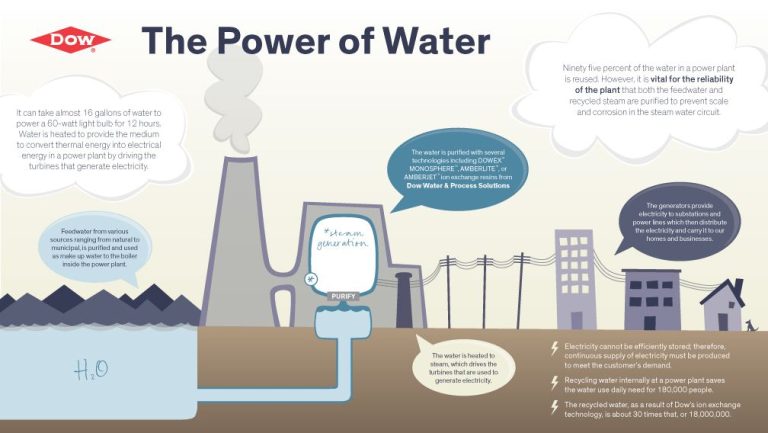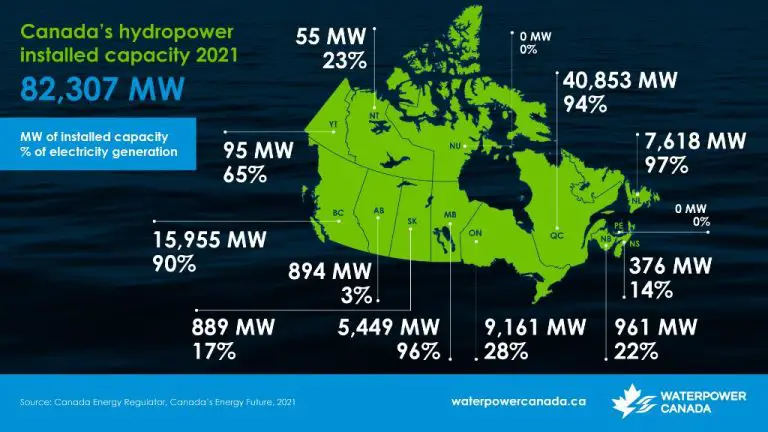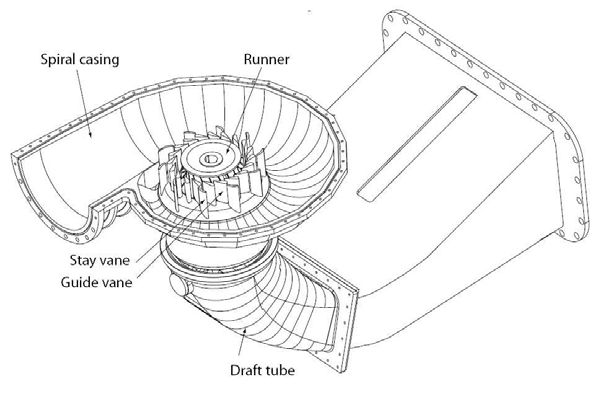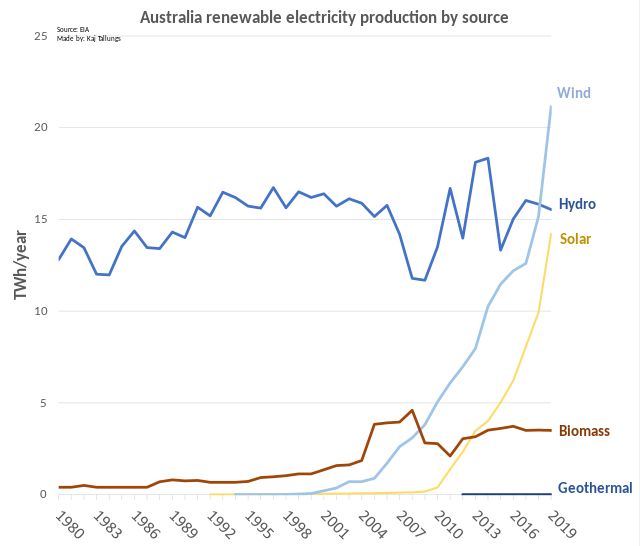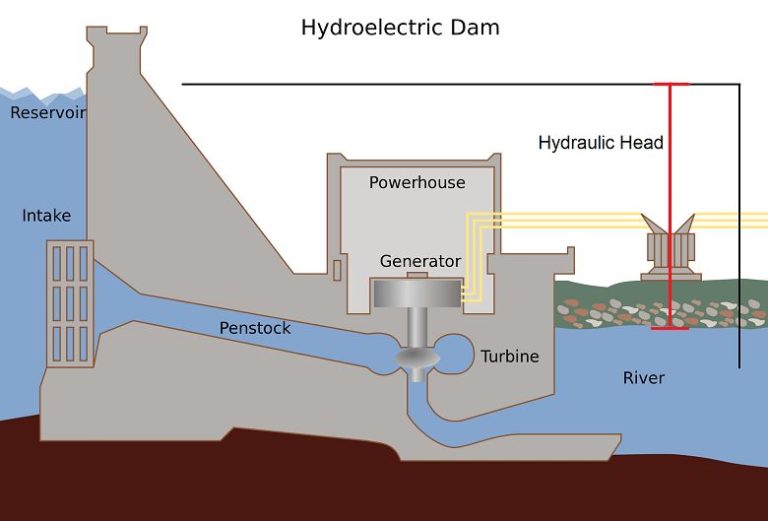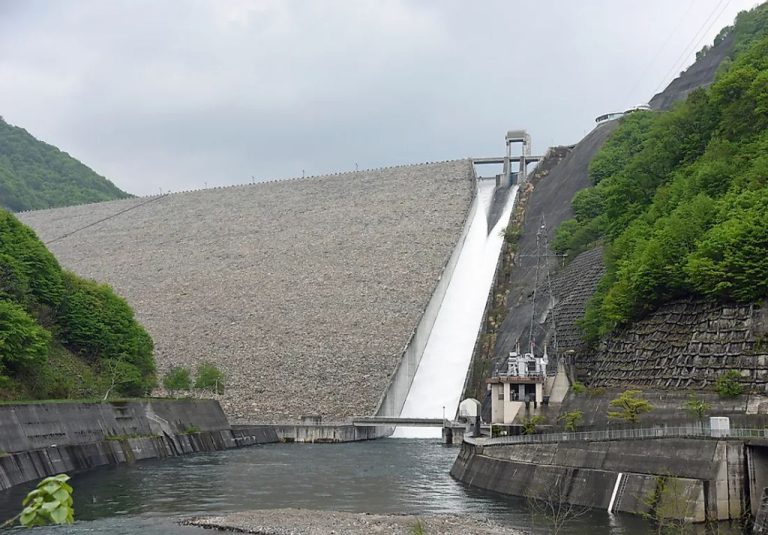At What Point Will Hoover Dam Stop Producing Electricity?
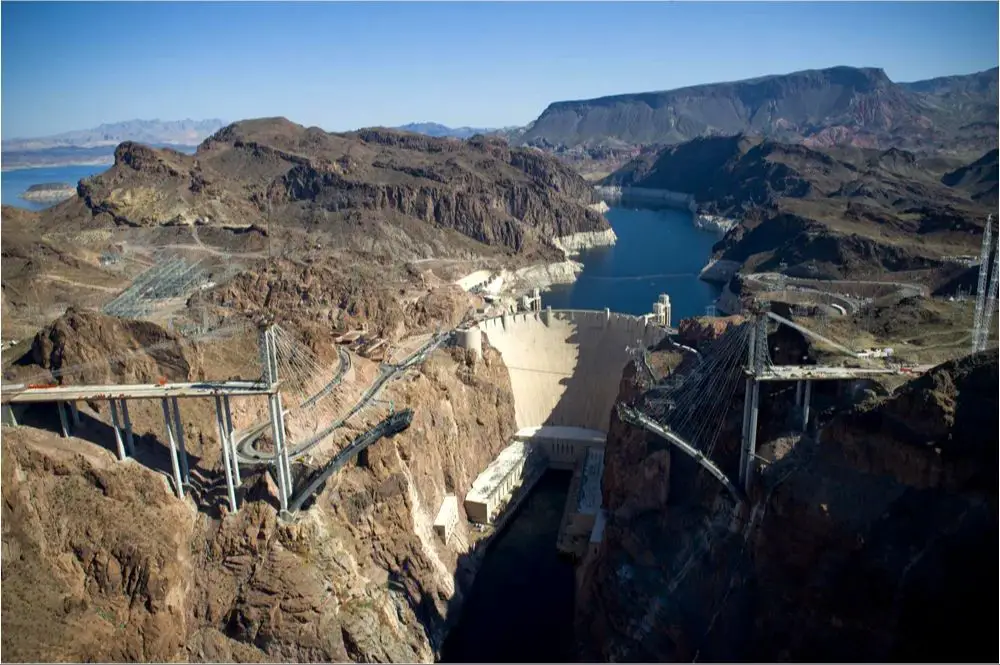
Hoover Dam is a concrete arch-gravity dam in the Black Canyon of the Colorado River, on the border between the U.S. states of Nevada and Arizona. It was constructed between 1931 and 1936 during the Great Depression and was dedicated on September 30, 1935 by President Franklin D. Roosevelt. Its main purposes are to provide hydroelectric power, provide irrigation water, control floods, and store water for recreation and other public purposes.[1]
The dam is located about 30 miles southeast of Las Vegas, Nevada and impounds Lake Mead, the largest reservoir in the United States. It stands 726 feet tall and 1,244 feet long at its crest. Construction of the dam involved thousands of workers and over 100 deaths.[2] Since completion, Hoover Dam has become an iconic American landmark and helped develop the Southwest into an economic force.
Hoover Dam’s Electricity Generation
The Hoover Dam contains 17 main turbines and generators that produce hydroelectric power from the flow of the Colorado River. According to the Bureau of Reclamation, the maximum capacity of the Hoover Power Plant is 2,074 megawatts (MW) [1].
This includes the original 17 main generators that have a capacity of 1,936 MW, plus two station service units installed in 1986 that can generate 108 MW. At full capacity, the plant can produce over 4 billion kilowatt-hours of electricity per year, enough to serve over 1 million average households [1].
The dam’s electricity generation varies seasonally based on water flow and demand. According to the U.S. Energy Information Administration, the average monthly capacity ranges from around 1,000 MW in the winter months to 1,250 MW in the summer [2].
Factors Impacting Hoover Dam’s Electricity Production
Two key factors are impacting Hoover Dam’s ability to generate electricity – sedimentation and climate change affecting water levels in Lake Mead. Sedimentation refers to the buildup of silt and sediment carried by the Colorado River, which has accumulated at a faster rate than anticipated since the dam was built in the 1930s. This reduces the storage capacity of Lake Mead. According to the U.S. Bureau of Reclamation, Lake Mead could lose nearly all of its storage capacity due to sedimentation by 2100 if nothing is done[1].
Climate change and the drought in the western U.S. is severely impacting water levels in Lake Mead, which provides the water to power Hoover Dam’s electricity generation. Higher temperatures cause more rapid evaporation from the lake. Lake Mead’s water level has dropped to unprecedented lows, reducing Hoover Dam’s generating capacity. As of July 2022, the water level was at just 1,041 feet above sea level, with electricity generation down 25% from its peak[2]. Most experts predict water levels will continue declining as climate change exacerbates drought in the region.
Projected Lifespan
The Hoover Dam is an engineering marvel that has provided reliable hydropower to the southwestern United States since it first started operating its massive turbines in 1936. But how long can we expect this iconic dam to continue generating electricity?
According to experts, Hoover Dam could remain productive for at least another 50-100 years if properly maintained. The dam itself is structurally sound and its concrete construction is built to last thousands of years. However, the powerplant machinery has a shorter functional lifespan.
The turbines, generators, transformers and other equipment require periodic maintenance, upgrades and eventual replacement. The Bureau of Reclamation aims to extend the working life of this machinery as long as possible through proactive repairs and improvements. But inevitably, the physical equipment will wear out over the coming decades.
Most estimates suggest Hoover Powerplant can maintain around 70-80% of its nameplate capacity through 2050-2060. Beyond that time frame, output will progressively fall unless new equipment investments are made. But with proper care, the dam may continue producing some electricity for the next 100 years or more.
According to a post on Reddit (https://www.reddit.com/r/askscience/comments/1dtfad/whats_the_expected_lifetime_of_the_hoover_dam/), the Hoover Dam itself could theoretically last 10,000+ years with proper maintenance. But the power generation machinery likely has a functional lifespan of around 50-100 more years with upgrades.
Plans for Eventually Shutting Down
As water levels in Lake Mead continue to drop, federal and state officials have developed strategies for transitioning away from reliance on electricity from the Hoover Dam. According to an article on Newsweek.com, the seven U.S. states that rely on the dam’s power generation will need to find alternative sources when operations eventually halt.
Arizona, California, Colorado, Nevada, New Mexico, Utah and Wyoming benefit from the affordable and renewable hydroelectricity the dam provides. However, prolonged drought conditions in the Colorado River Basin have reduced the lake’s water levels significantly, threatening the dam’s ability to generate power. The states have worked together to devise shutdown plans that will replace the 2,080 megawatts of electricity.
Strategies include bringing additional power plants online, building new renewable sources like solar and wind farms, improving transmission infrastructure, and enacting conservation policies to reduce energy usage. For example, California aims to source 60% of its electricity from renewables by 2030. Regional planning helps minimize disruption when the inevitable shutdown happens.
While the Hoover Dam still produces power today, officials warn that without substantial precipitation in the region, it could cease operations within the next few years. The states are proactively taking steps for an orderly transition away from the iconic dam.[1]
Environmental Impact
The Hoover Dam has had significant ecological effects, both positive and negative, since its construction. The damming of the Colorado River created Lake Mead, which supports numerous species of fish, birds, and other wildlife that depend on the riparian habitat. However, the river’s flow downstream has been dramatically altered and reduced, impacting native vegetation and animals adapted to the river’s natural flooding cycles.
If the dam stops producing electricity, positive ecological changes could occur as the river returns to a more natural state. While Lake Mead would eventually disappear without the dam, the river would flow freely again. This could allow the recovery of native fish populations in the Colorado River basin, including endangered species like the humpback chub. Riparian vegetation would likely regenerate along sections of the river that have been starved of water. However, the abrupt ecological shift could also negatively impact or even eliminate some species that have adapted to the artificial lake habitat. Careful management of river flows would be needed to transition back towards a free-flowing state.
Overall, the Hoover Dam has enabled human development but at the cost of heavily altering natural ecosystems. Its electricity production shutting down could allow some recovery and restoration of the Colorado River’s ecology, but the disruption would need to be appropriately managed. A balanced approach informed by scientific study would be required to ensure the most beneficial environmental impacts as the dam’s operations cease.
Social & Economic Consequences
The Hoover Dam shutting down would have major social and economic impacts on the surrounding communities and region that depend on it for affordable electricity. According to an analysis by the U.S. Bureau of Reclamation, the Hoover Dam provides power to over 1 million people across Nevada, Arizona, and California [1]. Losing this source of renewable hydropower would raise electricity costs for households and businesses.
In addition, over 1,000 jobs are supported by the Hoover Dam and the tourist industry it attracts. If the dam stopped functioning, many of these jobs would be lost, hitting the economies of cities like Las Vegas and Laughlin, Nevada hard. The Bureau of Reclamation stated the dam generates over $3.3 billion in economic benefits yearly, so shutting it down would remove a major economic engine for the region [2].
Local officials and stakeholders would need to quickly develop plans to offset the job losses and find alternative power sources. Some investments in solar, geothermal and natural gas plants have already been made in preparation. But electricity costs would still likely rise, creating a heavy financial burden for residents [3]. Overall, the dam’s shutdown would significantly disrupt lives and economic activity throughout the Southwest.
Alternatives and Replacements
As water levels in Lake Mead continue to drop, Hoover Dam’s ability to generate hydroelectric power will decline. According to research from the U.S. Bureau of Reclamation, Hoover Dam could completely stop generating electricity if water levels in Lake Mead fall below 950 feet above sea level.
With climate change and prolonged drought threatening the Colorado River basin, experts are looking at alternative renewable energy sources that can compensate for the eventual loss of Hoover Dam’s hydroelectric production. Solar power has emerged as one of the most viable options. According to a 2019 study published in Nature Communications, installing solar panels on just 13% of the land currently occupied by U.S. hydroelectric dams could generate enough electricity to completely replace their output.
California and Arizona will need to continue investing in utility-scale solar farms and rooftop solar arrays to make up for diminishing hydroelectricity from Hoover Dam. Battery storage and transmission improvements will also be necessary to effectively integrate solar power into the existing grid.
While no single energy source can completely replace Hoover Dam’s contributions, pursuing a diverse mix of solar, wind, geothermal and energy efficiency will provide the region with a sustainable and renewable power supply for the future.
Preparing for a Post-Hoover Future
With the water levels in Lake Mead continuing to drop, at some point in the not-too-distant future, Hoover Dam will no longer be able to produce electricity (https://spectrumnews1.com/ca/la-west/weather/2023/04/13/exclusive-continuing-coverage–colorado-river-in-crisis). This will require major changes to infrastructure, policy, and conservation efforts in the Southwest.
New power plants will need to be built to replace the electricity generation capacity lost by the Hoover Dam shutdown. This could include natural gas, solar, wind, or other renewable energy sources. Upgrades to transmission infrastructure will also be needed to bring electricity from new plants to cities and towns.
Policy changes will be required to facilitate the transition away from reliance on the Hoover Dam. Tax incentives, subsidies, and regulations may be needed to encourage new power plant construction and transmission upgrades. Water use policies in the Southwest will also have to adapt to diminished Colorado River flows.
Lastly, aggressive conservation efforts will be crucial. Municipalities and agriculture must find ways to use less water and electricity. Public education campaigns can encourage residents to reduce consumption. Investments in water recycling, desalination, stormwater capture, and efficiency upgrades will also help regions adapt.
While daunting, with proper coordination the Southwest can prepare for a post-Hoover future. But action must begin now before the Hoover Dam’s electricity production declines further.
Conclusion
Hoover Dam has been an invaluable source of electricity and important infrastructure project for nearly 100 years. However, it will not produce power indefinitely. While the exact year is unknown, projections indicate the dam could cease generating electricity within the next 50-100 years due to diminishing water levels in Lake Mead and the natural buildup of sediment in the reservoir.
While the dam was an engineering marvel of its time, we must now look to the future and develop solutions to replace the electricity and services Hoover provides. Steps like upgrading transmission lines, diversifying energy sources, and implementing water conservation measures will be essential to ensure a smooth transition. With proactive preparation, we can maintain energy reliability and continue meeting the needs of communities across the Southwest.
Though the iconic dam will one day go offline, Hoover’s legacy will live on through the cities it powered and irrigation it facilitated for decades. With long-term vision, we can build on that legacy and develop a sustainable energy future.

